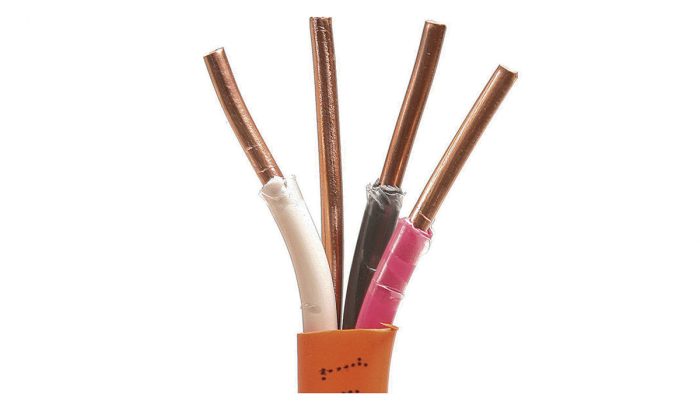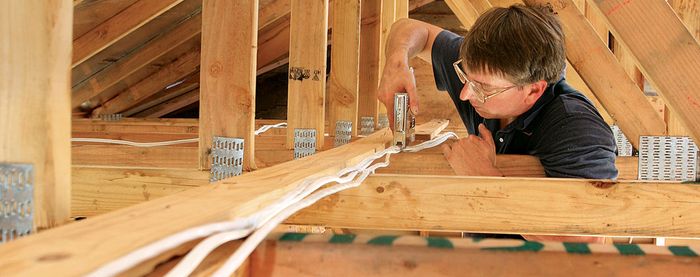Sizing Up Electrical Cable
Choosing the right kind of electrical wire for a circuit in your house depends on how much current it will carry, where it's going, and what local codes require.

Most houses have a mix of electrical cables—different gauges (thicknesses) of wire for different circuits and different types of cable depending on where it’s installed. There are two basic questions that guide the choice of which type to use: How much current will the circuit be carrying, and where will the cable be located?
Ideally, these are questions best left to a licensed electrician. Still, many carpenters and homeowners occasionally install a simple circuit or repair an old one, so knowing what type of cable to use is important. When in doubt, hire a licensed electrician to do the work, or at least arrange for a licensed electrician to check what you’ve done. And check with your local building office to see what licenses or permits will be required.
Bigger loads, heavier wire
First, some terminology. Although “wire” and “cable” are often used interchangeably, wire actually refers to a single electrical conductor. When multiple wires are bundled together, what you have is a cable.
No matter what type of cable you are buying, the gauge of the individual wires will determine how much current the cable can safely handle. The lightest gauge used in a household circuit is 14 ga., which is rated for 15 amps (lamps and other electrical devices often use a lighter gauge than 14). The heavier the wire, the more current it can handle: 12 ga. is for 20-amp circuits; 10 ga. is for 30-amp circuits; and 8 ga. is for 40-amp circuits.
Light fixtures and household receptacles are good candidates for 14-ga. wire. Large household appliances, such as an electric range or a clothes dryer, typically will get 10-ga. or 8-ga. wire. The choice depends on how much current the device draws, information that should be available on a tag attached to the device.
Conductors for branch circuits are made of copper, although some older wiring may be aluminum. Large-capacity circuits, like a service entrance (SE cable) for a house, may be aluminum. Check with your local building official to see if it’s permitted in your area.
Nonmetallic Cable
Nonmetallic (NM) cable consists of a number of conductors (typically three or four) protected by PVC sheathing. It’s often called Romex, after the Rome Wire Company that invented it around 1920. Romex is now a registered trademark of the Southwire Company.
NM cable is the most common type of residential electrical cable. It’s widely available, relatively inexpensive, and easy to work with. The outer vinyl sheathing is not especially robust, so it’s easy to nick or cut it and expose the conductors. NM cable is intended for protected locations—inside wall cavities, for example—not out in the weather or buried in the back yard.
Inside the sheathing are individual wires. Wires coated in black and white plastic are the hot and neutral conductors, respectively. The bare wire is the ground. Some types of NM cable have more than two coated conductors. This information should be printed on the outside of the vinyl sheathing. So, for example, when you see “12-2 WG” you’re looking at two 12-ga. conductors and a ground wire; “12-3” means three 12-ga. conductors.
“NM-B” means the cable is rated for locations where temperatures go up to 90ºC (194ºF). The maximum voltage rating for the cable will be stamped on the vinyl sheathing—600v for NM-B.
Check the color
To keep things straight, most manufacturers use a color code to identify different types of NM cable: white means 14 ga.; yellow is 12 ga.; orange is 10 ga.; and black is either 6 ga. or 8 ga. This helps building inspectors, renovators, and homeowners identify the type of cable at a glance.
Some cable is gray in color. This means it’s UF, or underground feeder, which is the only type of NM cable that should be buried. Unlike NM cable, the conductors in UF cable are completely encased in plastic.
Armor-clad and metal-clad cable
Another family of cable used for residential wiring comes wrapped in flexible metal sheathing. Armor-clad (often called “BX”) and metal-clad cable are preferred by some electricians because the metal sheathing is less prone to damage than the vinyl covering on NM cable.
Armor-clad (AC) cable consists of individual conductors wrapped in paper and an outer sheathing of steel or aluminum. Inside is a separate bonding wire that, in conjunction with the metal sheathing, serves as the grounding wire (by itself, the bonding wire is not an adequate equipment ground). Because the sheathing is the ground, you’ll have to use metal, not plastic, receptacle and switch boxes.
Metal-clad (MC) cable is a little different. It also uses a flexible metal sheathing and one or more conductors, but the metal sheathing doesn’t count as a ground. MC cable requires a bare or green grounding conductor. MC cable can be used in more locations than AC cable.
Because of the metal sheathing, AC and MC cable are more difficult to cut (and more expensive) than NM cable. If you’re making more than a few cuts, it might be worth investing in a rotary cable cutter.
When and where each of these types of cables may be used (and where they are prohibited) are spelled out in the National Electrical Code. If you don’t have a copy, a summary published in Electrical Construction & Maintenance by Mike Holt, a NEC trainer, is available here. Keep in mind that local requirements may be different.





View Comments
If you need to know the wire size in a remodel, do not rely on the color of the existing cabling. Read the imprinted size on the sheathing.
While newer houses will have color-coded cabling in them, this article is addressed to people working on existing houses. So it would be useful to stress that the color code you mentioned (white, yellow, orange, black) only applies to recently constructed houses. I don't remember for sure when it began, but before that most residential cabling was white. Or sometimes light blue and probably other colors, too, depending on the brand of the cable. While I've put some yellow and even orange cable into remodeled houses, I've never opened one up with the modern color coded cabling.
Very Nice and Informative!
Good Job!
Amazing job!
Very nice!